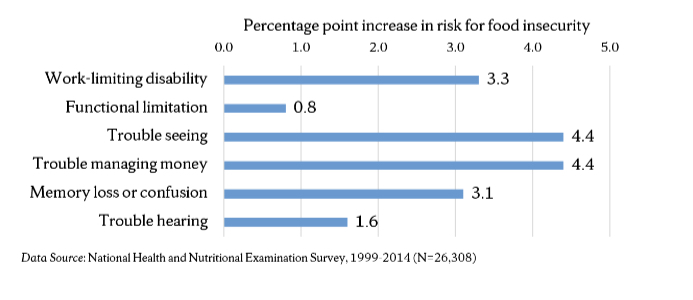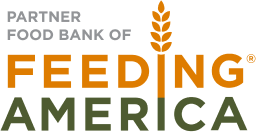Federal assistance programs are especially critical for the disabled community
1 in 5 SNAP households has a member with disabilities
By Emily Gallion, Grant & Metrics Manager/Advocacy Manager, and Caitlyn McIntosh, Volunteer & Intake Support
Despite assistance programs for disabled individuals, including Supplemental Security Income (SSI) and Social Security Disability Insurance (SSDI), they are more likely to experience food insecurity than their able-bodied peers. Strikingly, 1 in 5 SNAP households have at least one disabled member.
Studies show that poverty rates are high among disabled Americans. In 2019, the poverty rate for this population was nearly 27%, which was more than twice the rate for able-bodied individuals.
Disabled people also may have difficulties accessing charitable food assistance, including transportation barriers, trouble preparing food received from a pantry, and inaccessible food distribution measures. This can be largely impacted by the type of disability they are living with.
One study from Syracuse University identifies work-limiting disability, physical limitations, and cognitive limitations all increase the risk of food insecurity in their own unique ways.

Those with work-limiting disabilities can use their work history to lean on federal programs like SSDI and SSI. Physical limitations may require more support from community resources like home delivery programs or transportation providers, as their independence may be hindered due to mobility difficulties.
Currently, there are no social programs that address the food needs of those living with cognitive limitations. Memory loss, confusion, and trouble managing money significantly raise the risk of food insecurity in this population.
Federal regulation requires The Foodbank and our partner agencies to ensure equal access for our disabled clients. We also host twice-weekly drive-thru food distributions, which may be a good fit for individuals with mobility issues.
Despite these accommodations, federal programming, including the Supplemental Nutrition Assistance Program (SNAP), are especially critical for this population. SNAP allows recipients to purchase food on their own schedule and according to their own preferences or health-related dietary concerns.
It is also worthy to note that food insecurity, for disabled and able-bodied people alike, is a public health issue. One study found that disabled individuals who also experienced food insecurity were more likely to report poor physical health, poor mental health, and underutilization of health care services.
SNAP: Strengths and Limitations
SNAP currently includes measures that support individuals experiencing food insecurity. People who qualify for SSI or SSDI automatically qualify for SNAP benefits as well.
However, not everyone who qualifies for this program receives these benefits. Research indicates that only 68% of people who receive SSI also receive SNAP benefits. The application process for SNAP can be a barrier for this population.
The Foodbank conducts SNAP application assistance to help streamline the process and pre-screen clients for eligibility. Those interested in applying for SNAP are encouraged to call our hotline at 937-476-1486 or fill out the online interest form here.
While organizations like The Foodbank that conduct SNAP outreach can help more people access these benefits, simpler solutions exist. Some states have implemented Combined Application Projects (CAP), which help people apply for both SSI and SNAP at the same time.
Disabled individuals who receive SNAP benefits, or who are 60 years or older, are also able to deduct out-of-pocket medical expenses over $35 from their countable income, which can help them qualify for a higher SNAP benefit. However, this deduction is underutilized: only 9 percent of SNAP households with disabled members claimed this deduction.
According to the Food Research Access Center, there are two major ways this issue can be addressed. One is for organizations serving disabled individuals to conduct outreach to increase awareness of the deduction, and another is for states to implement a Standard Medical Deduction (SMD).
The SMD provides a standardized amount to individuals who are able to verify expenses over $35 per month. This amount varies based on which state has implemented the policy. The SMD also prevents recipients from having to track every medical expense that may qualify for the deduction, which can be burdensome.
Disabled people and able-bodied people alike can also benefit from the same improvements to SNAP. These include measures that simplify application and recertification processes, provide greater access to prepared foods, and increased benefit payments.
To learn more about how federal food programs can be more inclusive for disabled people, visit Feeding America’s resource here.





No comment yet, add your voice below!